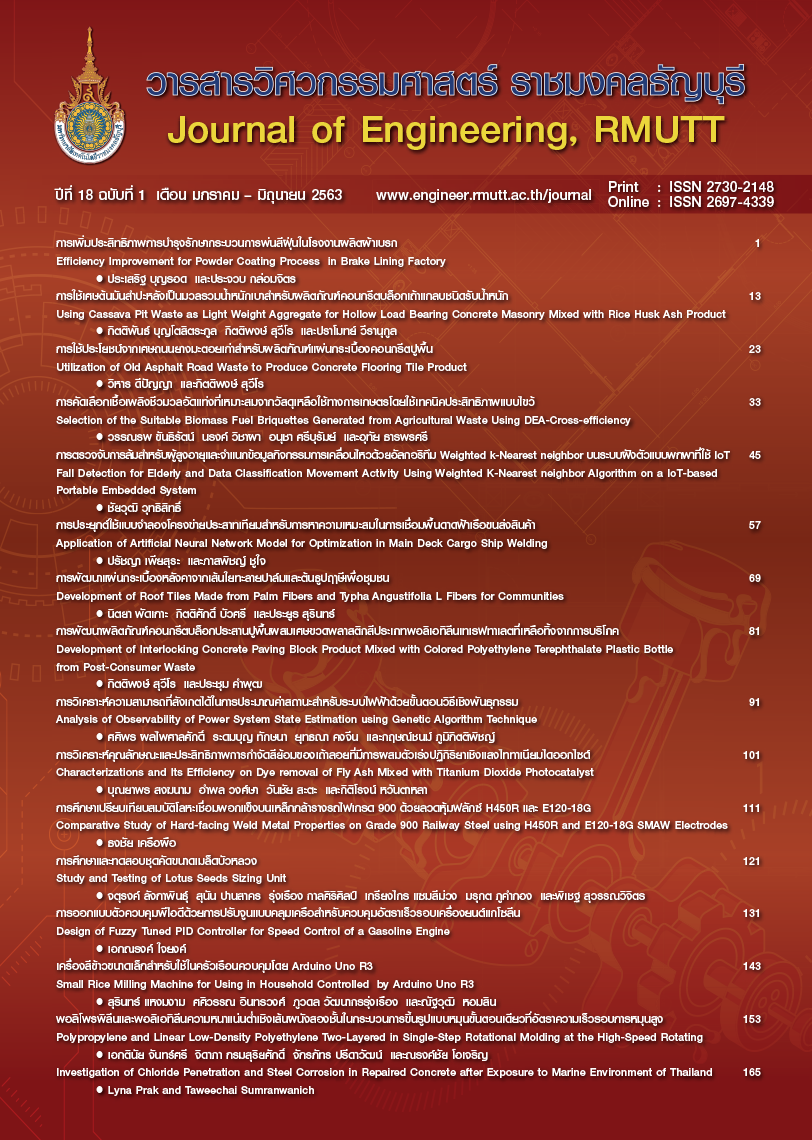การประยุกต์ใช้แบบจำลองโครงข่ายประสาทเทียมสำหรับการหาความเหมะสมในการเชื่อมพื้นดาดฟ้าเรือขนส่งสินค้า
Main Article Content
บทคัดย่อ
งานวิจัยนี้ได้นำเสนอวิธีการหาความเหมาะสมในการเชื่อมพื้นดาดฟ้าเรือขนส่งสินค้าด้วยกระบวนการเชื่อมใต้ฟลักซ์ในเหล็กกล้าความแข็งแรงสูง เกรด ASTM A131 EH36 โดยการสร้างแบบจำลองทางคณิตศาสตร์สำหรับการทำนายค่าความเค้นแรงดึง ด้วยเทคนิคโครงข่ายประสาทเทียม ชนิดการแพร่ค่าย้อนกลับ ลักษณะการเรียนรู้แบบมีผู้สอน มีปัจจัยที่ศึกษา ได้แก่ กระแสไฟฟ้า แรงดันไฟฟ้า และความเร็วในการเชื่อม หลังจากทำการเชื่อมได้มีการทดสอบค่าความเค้นแรงดึง การดัดโค้ง การวิเคราะห์โครงสร้างจุลภาคด้วยกล้องจุลทรรศน์อิเล็กตรอนแบบส่องกราด และการสร้างแบบจำลองโครงข่ายประสาทเทียม ด้วยวิธีฝึกสอนอัลกอริทึมการเรียนรู้แบบเลเวนเบิร์ก-มาร์ค ฟังก์ชั่นปรับการเรียนรู้ ชนิดการเคลื่อนลงตามความชัน และชนิดการเคลื่อนลงตามความชันด้วยโมเมนตัม รูปแบบฟังก์ชั้นการกระตุ้น ในงานวิจัยได้ใช้ฟังก์ชั่นลอก-ซิกมอยด์สำหรับชั้นนำเข้า ฟังก์ชั่นแทน-ซิกมอยด์สำหรับชั้นซ่อนที่ 1 และชั้นซ่อนที่ 2 ฟังก์ชั่นเพียวรินสำหรับชั้นผลลัพท์ ผลการวิจัยพบว่าแบบจำลองโครงข่ายประสาทเทียมที่เหมาะสมในการทำนายค่าความเค้นแรงดึง ประกอบด้วยนิวรอนในชั้นอินพุต 3 นิวรอน นิวรอนในชั้นซ่อนที่ 1 จำนวน 8 นิวรอน นิวรอนในชั้นซ่อนที่ 2 จำนวน 10 นิวรอน และนิวรอนในชั้นแสดงผล 1 นิวรอน (3-8-10-1) ชนิดของฟังก์ชั่นปรับการเรียนรู้ชนิดการเคลื่อนลงตามความชัน มีค่าเฉลี่ยผิดพลาดกำลังสองที่ 0.000106 มีค่าสัมประสิทธิ์การตัดสินใจที่ 0.99947 สภาวะการเชื่อมที่เหมาะสมที่ได้จากการทำนายจากแบบจำลองโครงข่ายประสาทเทียม ที่กระแสไฟฟ้า 340 แอมแปร์ แรงดันไฟฟ้า 26 โวลต์ และความเร็วที่ใช้ในการเชื่อม 20 เซนติเมตรต่อนาที
Article Details
บทความ ข้อมูล เนื้อหา รูปภาพ ฯลฯ ที่ได้รับการตีพิมพ์ในวารสารแนวหน้าวิจัยนวัตกรรมทางวิศวกรรม ถือเป็นลิขสิทธิ์ของวารสารฯ เท่านั้น ไม่อนุญาติให้บุคคลหรือหน่วยงานใดคัดลอกเนื้อหาทั้งหมดหรือส่วนหนึ่งส่วนใดไปเผยแพร่เพื่อกระทำการใด ๆ ที่ไม่ถูกต้องตามหลักจริยธรรม
References
Wanchai M, Sumalee S, Suphattra l, Sompong S, Pramuan B, et al.Integrateddevelopment of shipbuilding and ship repairing industry: Executive summary. Transportation Institute, ChulalongkornUniversity. 2007(in Thai)
Tanawat S, Vithaya R,KittichaiS.Submerged arc welding process and ship building industry. The Journal of Welding Institute of Thailand. 2016;2(1):30-5. (in Thai)
Luiz H. S. B., Paulo J. M., Leonardo B. G. and Ariel R. A.Fatigue crack growth rates on the weld metal of high heat input submerged arc welding International,Journal of Fatigue 2019; 119: 43–51.
Layus P, KahP, Khlusova E,Orlov V.Study of the sensitivity of high-strength cold-resistant shipbuilding steels to thermal cycle of arc welding.International Journal of Mechanical and Materials Engineering. 2018; 13(3):1-9.
Tadeu M, Donizete B, Wagner D. F,LeonardoD. O. T,Ronaldo C. J.Assessmentof the weldability of EH36 TMCPshipbuilding steel welded by high heat input submerged arc welding, Welding International. 2017; 31(3):184-95.
Rong Y,Mi G,Xu J,Huang Y, Wang C.Laser penetration welding of ship steel EH36: A new heat source and application to predict residual stress considering martensite phase transformation, MarineStructure. 2018; 61:256-67.
X. R. Li, Y. M. Zhang,L. Kvidahl.Penetrationdepth monitoring and control in submergedarc welding, Welding Research. 2013; 92: 48-56.
Carole E, David T, Jean-Yves C, Manuel K.Fatigue life prediction of welded ship detail, Marine Structures, 2012;25(1): 13-32.
Liangbi L, Xiaomei G, Shaolong S, Wenjie W, Zhengquan W. et al.Effects of welding residual stresses on the vibration fatigue life of a ship's shock absorption support, Ocean Engineering. 2018; 170: 237-45.
Ke Z, Yixin C, Jian Z, Jian H,Xinhua T.Adaptive filling modeling of butt joints using genetic algorithm and neural network for laser welding with filler wire. Journal of Manufacturing Processes.2017; 30: 553-61.
A. Bagchi, S. Saravanan, G. Shanthos Kumar, G. Murugan,K. Raghukandan.Numerical simulation and optimization in pulsed Nd: YAG laser welding of Hastelloy C-276through Taguchi method and artificial neural network. Optik. 2017;146: 80-9.
A. Sarka, P. Dey, R. N. Rai,S. C. Saha.A comparative study of multiple regression analysis and back propagation neuralnetwork approaches on plain carbon steel in submerged-arc welding. Sadhana,2016; 41(5): 549–59.
L. Yu, K. Saida, S. Hirano, N. Chigusa, M. Mochizuki,K. Nishimoto.Application of neural network-based hardnesspredictionmethod to HAZ of A533B steel produced by laser temper bead wel-ding. Welding in the World, 2017; 61(3): 483–98.
D. Zhao, D. Ren, K. Zhao, S. Pan,X. Guo.Effect of welding parameters on tensile strength of ultrasonic spotwelded joints of aluminum to steel by experimenttation and artificial neuralnetwork.Journal of ManufacturingProcesses, 2017; 30: 63-74.
R.H. Myers, D.C Montgomery.Response surface methodology process andproduct optimization using designed experiments, 2 ed., USA: John Wiley and Sons: New Jersey; 2002.
American Society for Testing and Materials. ASTM E8 / E8M -16a Standard TestMethods for Tension Testing of Metallic Materials. American Society for Testing and Materials: Pennsylvania; 2013.
Montgomery DC., Design and Analysis of Experiments. USA: John wiley and son publishing, New York New; 2005.
M.S. Kaiser. Effect of heat input on the weld metal toughness of chromium-molybdenumsteel, International Journal of Chemical, Molecular, Nuclear, Materials Metallurgical Engineering. 2013;7: 33-5.
Weijun H, Yongjian Z, Xiaoli Z, Na X,Fangzhong H.High cycle fatigue behaviour of V-Microalloyed medium carbon steels:A comparison between bainitic and ferritic-pearlitic microstructures, InternationalJournal of Fatigue. 2016; 91:232-41.
Sergey G, Eva A, Maksim Z, Rudolf K, Ulrich P.Effect of spheroidization annealing on pearlite banding, Materials Science Forum, 2019; 949: 40-7.
MinwooK, Minsu J, Hyongjik L,Young-K.Microstructural evolution duringaustenitization and quenching of a 5% Cr work roll, Materials Transactions, 2012;53(11): 1915-21.
M. Saadat, A. K. E. Nobarzad, M. Jahazi.On the hot cracking of HSLA steel welds: role of epitaxial growth and HAZ grain size. Journal of ManufacturingProcesses. 2019; 41: 242-51.

